Doing these tests I was mainly interested to learn, how wide angle lenses behave when a strong light source like the sun is placed in front of the lens. How would the resulting sun star look? What kind of ghosting would occur and how much would the contrast suffer under such circumstances?
Thea reason I chose to test lenses of a 20mm range relates issues with photo composition and use of fliters. I like lenses of 24 mm, 20 mm or even wider and preferr to use polarizing and graduated ND filters. With lenses wider than 20 mm these filters become difficult to use.
I do a lot of mountain photography. So the size of a lens is an important factor minimize the weight of equipment. For this reason I have included a size comparison of tested lenses.
Introduction
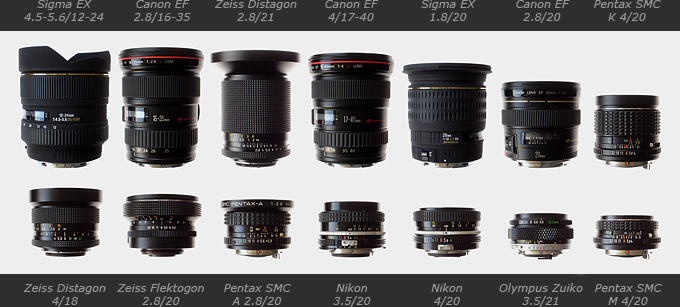
Below you find some informations that was helpful to me in selecting the lenses for my test. Newer lenses are more likely to be state of the art than older ones. It's easier to use a polarizer and a graduated ND filter at the same time on lenses with smaller filter sizes. The number of lenses/groups of a lens determins how many reflecting surfaces are there that might produce ghosting. The number of aperture blades determins how many rays the expected sun star will have.
| Aperture blades | 4 | 5 | 6 | 7 | 8 | 9 | ... |
| Rays | 4 | 10 | 6 | 14 | 8 | 18 | ... |
All listed lenses can be mounted on Canon EF by using an adapter or by converting the lens.
Canon
| tested | design | optic | blades | filter | length | weight | |
| EF 2.8/20-35 | no | 1989 | 15/12 | 8 | 72 mm | 89 mm | 570 g |
| EF 2.8/20 | yes | 1992 | 11/9 | 6 | 72 mm | 71 mm | 405 g |
| EF 3.5-4.5/20-35 | no | 1993 | 12/11 | 5 | 77 mm | 69 mm | 340 g |
| EF 2.8/17-35 | no | 1996 | 15/10 | 7 | 77 mm | 96 mm | 545 g |
| EF 2.8/16-35 | yes | 2001 | 14/10 | 7 | 77 mm | 103 mm | 600 g |
| EF 4/17-40 | yes | 2003 | 12/9 | 7 | 77 mm | 97 mm | 475 g |
| EF 2.8/16-35 II | no | 2007 | 16/12 | 7 | 82 mm | 112 mm | 635 g |
The Canon EF 2.8/16-35 II is said to be sharper and has better flare control than its predecessor. Flare control should be comparable to the Canon EF 4/17-40.
Carl Zeiss
| tested | design | optic | blades | filter | length | weight | |
| Distagon 4/18 | yes | 1967 | 10/9 | 6 | 86 mm | 60 mm | 320 g |
| Distagon 2.8/21 | yes | 1993 | 15/13 | 6 | 82 mm | 97 mm | 530 g |
| Vario-Sonnar 2.8/17-35 | no | 2002 | 15/10 | 8 | 95 mm | 96 mm | 900 g |
| ZE Distagon 3.5/18 | no | 2008 | 13/11 | 9 | 82 mm | 84 mm | 470 g |
| ZE Distagon 2.8/21 | no | 2008 | 16/13 | 9 | 82 mm | 109 mm | 600 g |
The Distagon 2.8/21 is a bit heavy and due to this complex optical construction and somewhat prone to flare. Apart from that it is said to be the "king of 20 mm lenses".
The Vario-Sonnar 2.8/17-35 is said to be a very good lens on its wide end and it can be converted to Canon EOS mount. Converted, it even supports autofocus and autoaperture. Unfortunately, it is very heavy and uses very big filters.
The new ZF lenses are said to have very good flare control. They have 9 aperture blades, so the sun star should be similar to the one of the Sigma EX 1.8/20.
The Vario-Sonnar 2.8/17-35 is said to be a very good lens on its wide end and it can be converted to Canon EOS mount. Converted, it even supports autofocus and autoaperture. Unfortunately, it is very heavy and uses very big filters.
The new ZF lenses are said to have very good flare control. They have 9 aperture blades, so the sun star should be similar to the one of the Sigma EX 1.8/20.
Carl Zeiss Jena
| tested | design | optic | blades | filter | length | weight | |
| Flektogon 4/20 | no | 1962 | 10/6 | 6 | 77 mm | 59 mm | 320 g |
| Flektogon 2.8/20 | yes | 1976 | 9/8 | 6 | 67 mm | 55 mm | 350 g |
The Flektogon 4/20 is singel-coated only. Which makes it not worthwhile for my purposes.
There are many differing opinions about the Flektogon 2.8/20. This probably means there is a lot of sample variation.
There are many differing opinions about the Flektogon 2.8/20. This probably means there is a lot of sample variation.
Leica
| tested | design | optic | blades | filter | length | weight | |
| Super Angulon 4/21 | no | 1968 | 10/8 | 4 | 72 mm | 44 mm | 420 g |
| Elmarit 2.8/19 | no | 1975 | 9/7 | 6 | - | 60 mm | 500 g |
| Elmarit 2.8/19 II | no | 1990 | 12/10 | 6 | - | 60 mm | 560 g |
| Vario Elmar 3.5-4/21-35 | no | 2002 | 9/8 | 6 | 67 mm | 66 mm | 500 g |
The Elmarit 2.8/19 II is reported to be an excellent lens. Unfortunately, you can't adapt it to Canon EOS without modifying the lens or shaving the mirror of the body. Furthermore it is difficult to use polarizing and graduated ND filters because there is no filter thread.
The older Elmarit 2.8/19 and the Super Angulon 4/21 can be adapted to Canon EOS without problems. But they are reported to be poorer performers concerning both, sharpness and flare. The Super Angulon 4/21 has four aperture blades only which produces a sun star with only 4 rays.
The Vario-Elmar 3.4-4/21-35 has got 9/8 lenses/groups only. This could mean that flare is well controlled. Also it is not very heavy and takes relatively small filters. It is to said be sharper on its long end than on its wide end. It can be used on an EOS 1Ds with an easy modification. Unfortunately you can get problems if you want use it on an EOS 5D - depending on the thickness of the adapter and mirror variations of the body the mirror might hit the rear element of the lens.
The older Elmarit 2.8/19 and the Super Angulon 4/21 can be adapted to Canon EOS without problems. But they are reported to be poorer performers concerning both, sharpness and flare. The Super Angulon 4/21 has four aperture blades only which produces a sun star with only 4 rays.
The Vario-Elmar 3.4-4/21-35 has got 9/8 lenses/groups only. This could mean that flare is well controlled. Also it is not very heavy and takes relatively small filters. It is to said be sharper on its long end than on its wide end. It can be used on an EOS 1Ds with an easy modification. Unfortunately you can get problems if you want use it on an EOS 5D - depending on the thickness of the adapter and mirror variations of the body the mirror might hit the rear element of the lens.
Minolta
| tested | design | optic | blades | filter | length | weight | |
| MC Rokkor 2.8/21 | no | 1971 | 12/9 | 6 | 72 mm | 67 mm | 515 g |
| MD Rokkor 2.8/20 | no | 1977 | 10/9 | 6 | 55 mm | 44 mm | 240 g |
Minolta lenses have to be converted for use on Canon EOS bodies.
Nikon
| tested | design | optic | blades | filter | length | weight | |
| Nikkor 3.5/20 UD | no | 1967 | 11/9 | 7 | 72 mm | 58 mm | 390 g |
| Nikkor 4/20 | yes | 1974 | 10/8 | 7 | 52 mm | 36 mm | 210 g |
| Nikkor 3.5/20 | yes | 1977 | 11/8 | 7 | 52 mm | 41 mm | 235 g |
| Nikkor 2.8/20 | no | 1984 | 12/9 | 7 | 62 mm | 43 mm | 260 g |
The older Nikon 3.5/20 UD is singel-coated only.
According to Bjørn Rørslett the newer 3.5/20 is much more suited for direct sun light than the 2.8/20.
The Nikkor 4/20 was a favorite lens of Galen Rowell. Ken Rockwell is also a fan.
According to Bjørn Rørslett the newer 3.5/20 is much more suited for direct sun light than the 2.8/20.
The Nikkor 4/20 was a favorite lens of Galen Rowell. Ken Rockwell is also a fan.
Olympus
| tested | design | optic | blades | filter | length | weight | |
| Zuiko 3.5/21 | yes | 1973 | 7/7 | 6 | 49 mm | 31 mm | 185 g |
| Zuiko 2/21 | no | 1979 | 11/9 | 6 | 55 mm | 44 mm | 250 g |
There is a singel-coated and a multi-coated version of the Olympus Zuiko 3.5/21. For my tests I used the multi-coated copy of this lens. More you can find more about this in the Olympus Zuiko 3.5/21 special.
The Zuiko 3.5/21 has less lenses/groups than the Zuiko 2/21. This probably means that the Zuiko 3.5/21 is less prone to flare than the Zuiko 2/21.
The Zuiko 3.5/21 has less lenses/groups than the Zuiko 2/21. This probably means that the Zuiko 3.5/21 is less prone to flare than the Zuiko 2/21.
Pentax
| tested | design | optic | blades | filter | length | weight | |
| Takumar SMC 4.5/20 | no | 1971 | 11/10 | 5 | 58 mm | 45 mm | 246 g |
| SMC K 4/20 | yes | 1975 | 12/10 | 5 | 58 mm | 57 mm | 300 g |
| SMC M 4/20 | yes | 1977 | 8/8 | 5 | 49 mm | 30 mm | 150 g |
| SMC A 2.8/20 | yes | 1985 | 10/9 | 5 | 67 mm | 44 mm | 245 g |
The Takumar 4.5/20 is reported to be prone to flare and pretty soft in the corners.
Sigma
| tested | design | optic | blades | filter | length | weight | |
| EX 2.8-4/17-35 | no | 1998 | 16/13 | 8 | 77 mm | 89 mm | 560 g |
| EX 1.8/20 | yes | 2000 | 13/11 | 9 | 82 mm | 90 mm | 520 g |
| EX 3.5-4.5/15-30 | no | 2001 | 17/13 | 8 | - | 133 mm | 620 g |
| EX 2.8/20-40 | no | 2001 | 17/13 | 9 | 82 mm | 108 mm | 600 g |
| EX 4.5-5.6/12-24 | yes | 2003 | 16/12 | 6 | - | 103 mm | 600 g |
Tamron
| tested | design | optic | blades | filter | length | weight | |
| SP 2.8-4/17-35 | no | 2003 | 14/11 | 7 | 77 mm | 87 mm | 440 g |
Voigtländer
| tested | design | optic | blades | filter | length | weight | |
| Color Skopar SL II 3.5/20 | no | 2009 | 9/6 | 9 | 52 mm | 29 mm | 205 g |
Yashica
| tested | design | optic | blades | filter | length | weight | |
| Yashinon ML 3.3/20 | no | 11/9 | 72 mm | 56 mm | 370 g | ||
| Yashinon ML 3.5/21 | no | 1975 | 12/8 | 6 | 72 mm | 54 mm | 370 g |
The following images of the tested lenses were all taken at the same scale allowing comparison of the lens sizes directly.
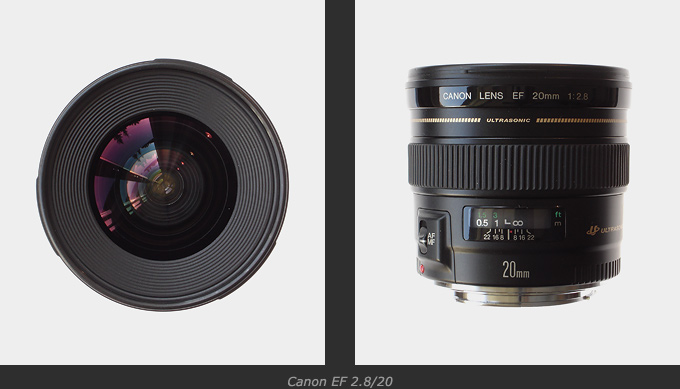
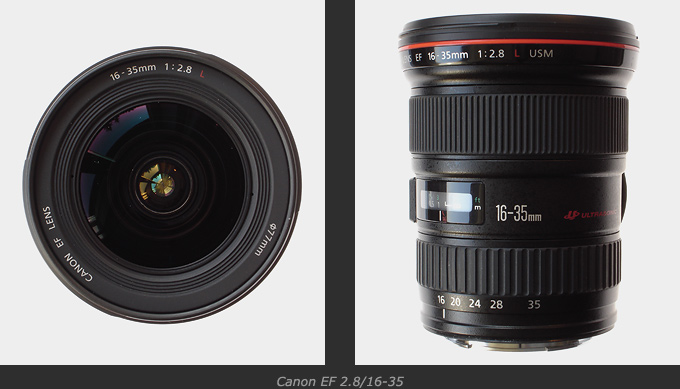
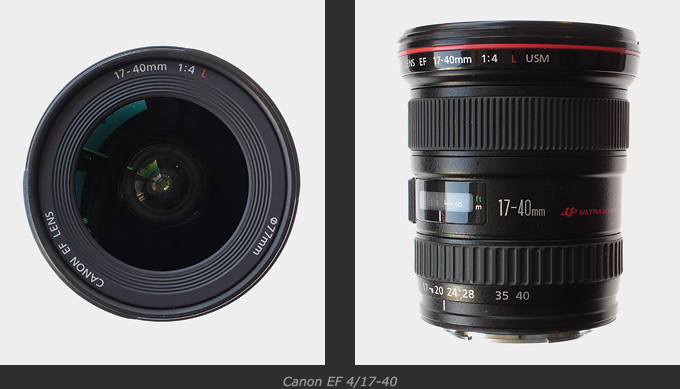
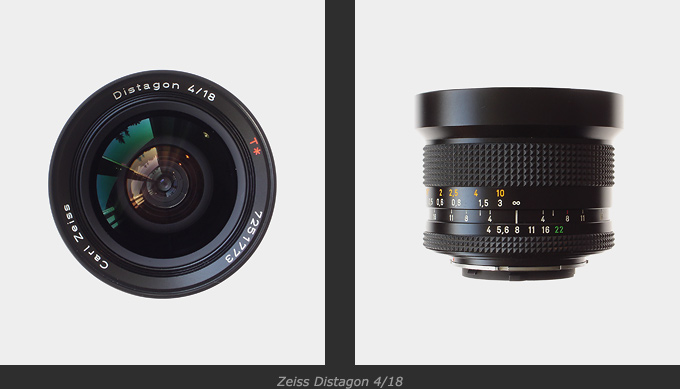
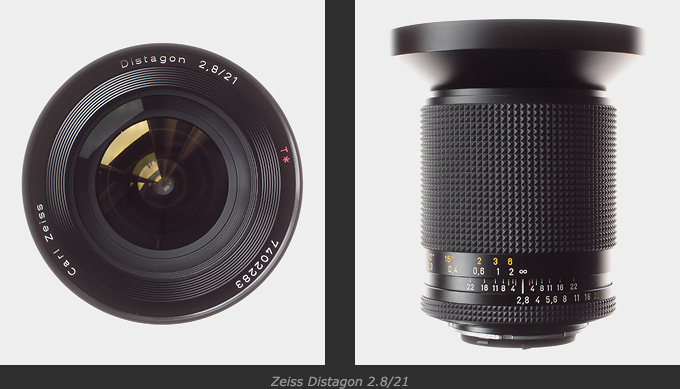
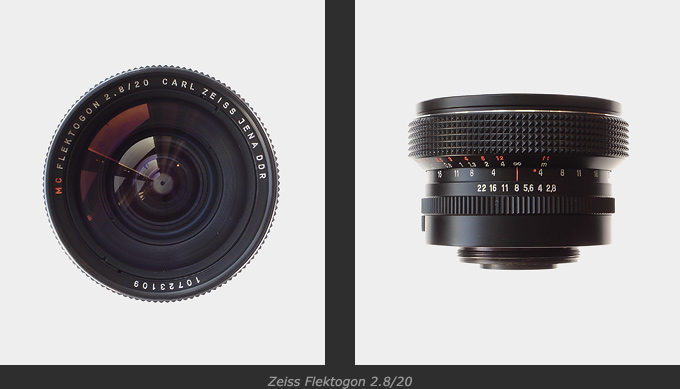
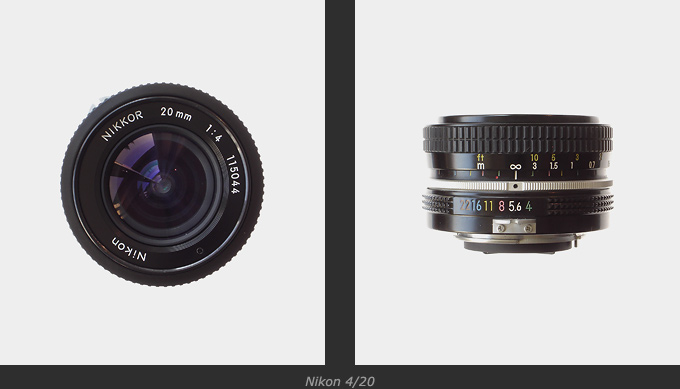
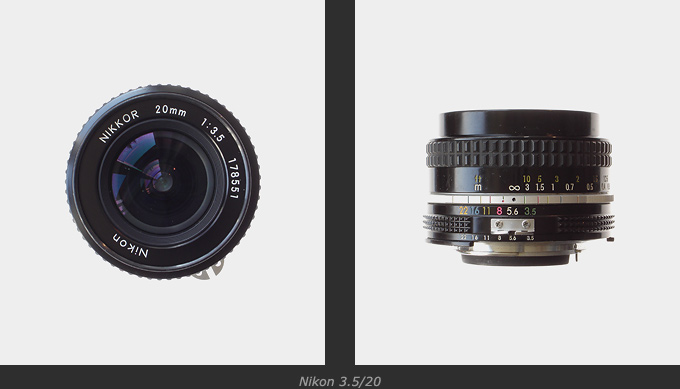
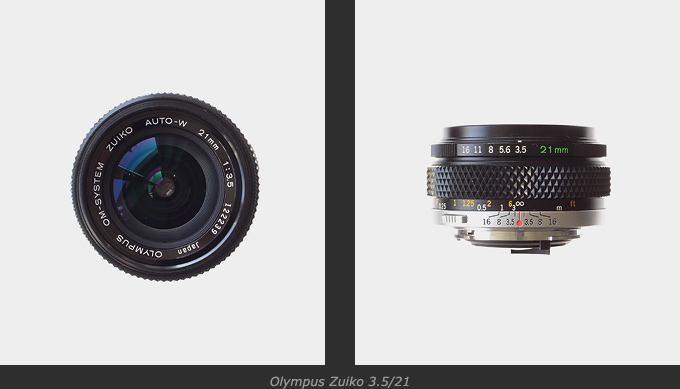
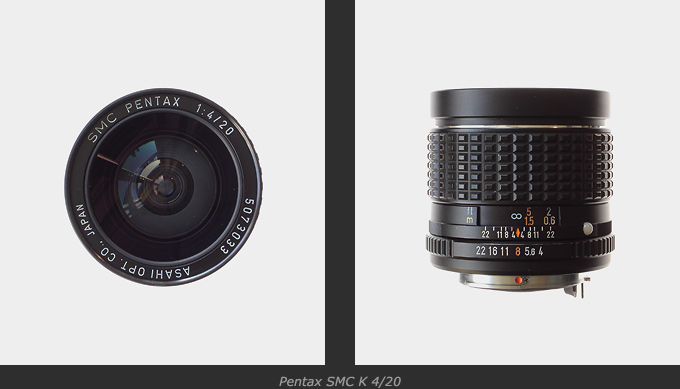
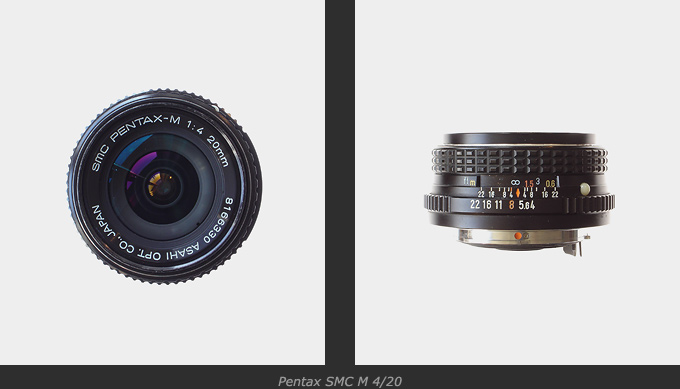
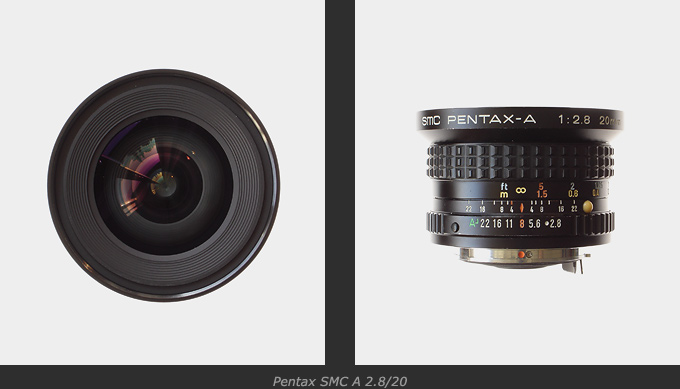
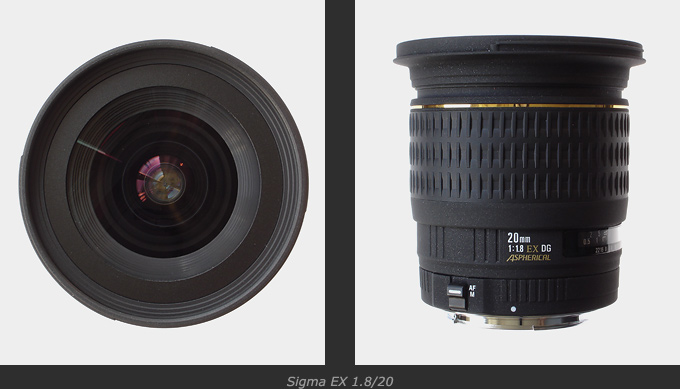
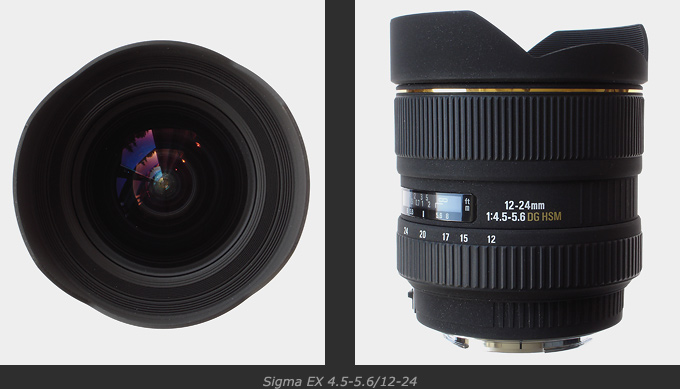
pictures and site copyright by stefan rohloff

 Deutsch
Deutsch